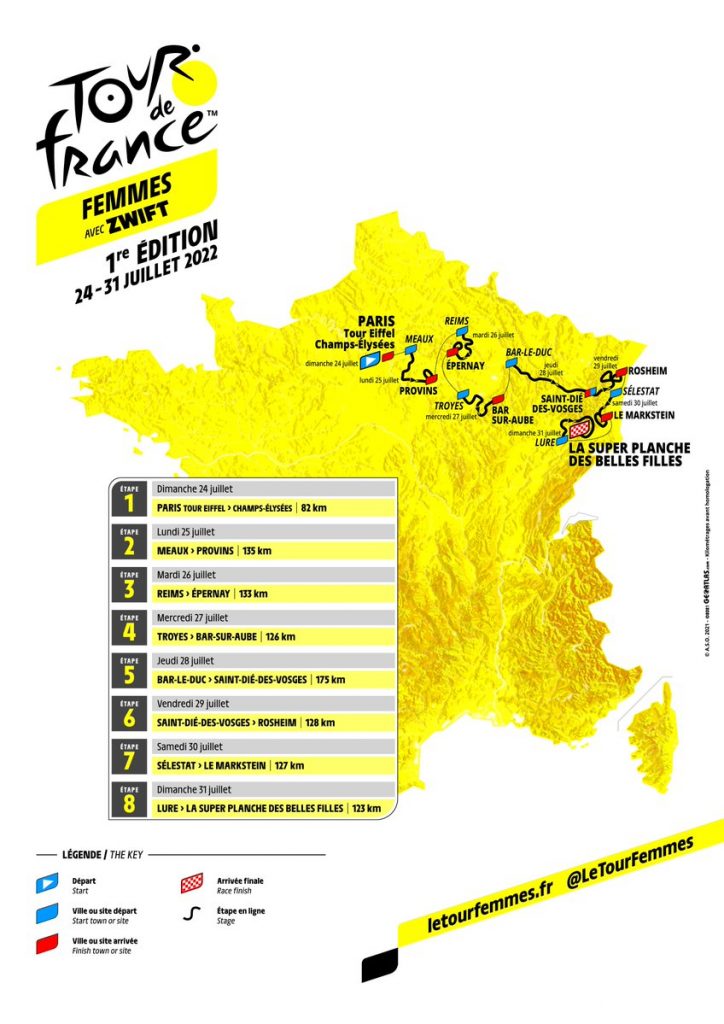The women’s Tour de France, which will be held for the first time in 33 years in 2022, is set to feature eight stages through eastern France.
Starting on the final day of the men’s Tour, the Tour de France Femmes will see competitors tackle two mountain stages – including a summit finish for the last stage.
The event takes place from 24-31 July.
The 21-stage route for the 2022 men’s Tour, which starts in Copenhagen, was also revealed on Thursday.
The race begins with a 13km time trial on 1 July and ends in Paris on 24 July.
After three days in Denmark, the first week will also feature a stage over cobblestones in northern France, a brief trip into Belgium and a summit finish on La Planche des Belles Filles.
The second week sees the riders tackle the Alps in Switzerland and France, including the famous climb of Alpe d’Huez on 14 July – Bastille Day in France.
The final week features two brutal summit finishes at Peyragudes and Hautacam before a 40km time trial on the penultimate stage and the traditional final-day finish on the Champs-Elysees.
“You have the entire palate of what it’s possible to provide on a Tour de France,” said course designer Thierry Gouvenou.
Slovenia’s Tadej Pogacar has won the past two Tour de France titles and will be favourite to win a third yellow jersey next year.
“It’s a very good course, interesting from the first to the last stage,” said Pogacar at the route announcement in Paris.
“There is a little more pressure on me having already won.”
Britain’s Mark Cavendish, who won his second green points jersey and equalled Eddy Merckx’s record of 34 stage wins at this year’s Tour, also attended the unveiling, though it is not yet clear whether he will be selected for the 2022 race.
Deceuninck-Quick-Step boss Patrick Lefevre has said Cavendish is close to agreeing a contract renewal, but the Belgian team may favour Fabio Jakobsen as their lead sprinter on a route featuring fewer flat stages than in 2021.
Organisers want women’s Tour to ‘still exist in 100 years’
The women’s peloton will set off from the centre of Paris and complete the route eight days later at the top of La Planche des Belles Filles.
There will be four flat stages and two over rolling terrain as well as the two mountain stages.
“It’s a balanced route that will suit several types of riders,” said women’s race director Marion Rousse.
Men’s Tour de France director Christian Prudhomme said he hopes the women’s race will have longevity on the calendar, but making it a financial success could prove tough.
“If it had been [sustainable], the women’s Tour would have been held for 40 years,” said Prudhomme.
You have the entire palate of what it’s possible to provide on a Tour de France,” said course designer Thierry Gouvenou.
Slovenia’s Tadej Pogacar has won the past two Tour de France titles and will be the favorite to win a third yellow jersey next year.
“It’s a very good course, interesting from the first to the last stage,” said Pogacar at the route announcement in Paris.
“There is a little more pressure on me having already won.”
Britain’s Mark Cavendish, who won his second green points jersey and equaled Eddy Merckx’s record of 34 stage wins at this year’s Tour, also attended the unveiling, though it is not yet clear whether he will be selected for the 2022 race.
Deceuninck-Quick-Step boss Patrick Lefevre has said Cavendish is close to agreeing on a contract renewal, but the Belgian team may favor Fabio Jakobsen as their lead sprinter on a route featuring fewer flat stages than in 2021.
Organisers want women’s Tour to ‘still exist in 100 years’
The women’s peloton will set off from the center of Paris and complete the route eight days later at the top of La Planche des Belles Filles.
There will be four flat stages and two over rolling terrain as well as the two mountain stages.
“It’s a balanced route that will suit several types of riders,” said women’s race director Marion Rousse.
Men’s Tour de France director Christian Prudhomme said he hopes the women’s race will have longevity on the calendar, but making it a financial success could prove tough.
“If it had been [sustainable], the women’s Tour would have been held for 40 years,” said Prudhomme.
“The biggest challenge is to broadcast the race. We’ve done a good job, with the race starting the same day as the men’s race ends in Paris.”
About 190 countries broadcast the men’s race, with Prudhomme estimating 170 countries will see the start of the women’s event.
In contrast to the men’s event, where 300 towns apply and pay to host a stage every year, Prudhomme had to approach candidates personally for the women’s race.
“But they are all paying an entry fee and to give you an element of comparison, it’s more than for [the week-long men’s stage races] Paris-Nice and the Criterium du Dauphine,” he added.
“The goal is to organise a race that will stay, that will still exist in 100 years, that I can watch when I’m old and using a walker.”
The original Tour de France Feminin ran alongside the men’s race with the same organisers from 1984 to 1989.
After being taken over by new organisers in 1990, a renamed women’s version of the Tour continued but had several schedule changes.
Men’s Tour organisers Amaury Sport Organisation (ASO) started running the women’s race La Course in 2014, but it has only been a one or two-day event in its eight editions to date.


